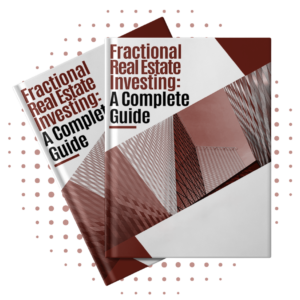
Commercial Real Estate is an important, and yet sometimes overlooked investment class. While many investors typically turn to the stock market, commercial real estate (CRE) properties can generate a lucrative stream of passive income without as much volatility.
In fact, the average 25-year return for private CRE properties has been known to outperform the S&P 500 Index. In Q1 2021, the average return on a CRE investment was 10.3% compared to 9.6% on the S&P 500.
With returns like that, investors can add a good deal of diversity and stability to their portfolios as well as reduce risk and maximize returns. Let’s take a look at the basics to help you decide if it’s right for you.
Jump to a Section:
What is Commercial Real Estate (CRE)?
Commercial Real Estate (CRE) refers to property that is used to conduct commercial business. This can include a variety of establishments from office spaces, industrial warehouses, retail locations and multi-family housing units.
The Basics of CRE
Office Space / Commercial Properties
Office spaces are one of the most common types of commercial real estate. These properties can occupy a small section of a commercial building or an entire building. In either case, they are spaces where business is conducted in an office setting. Some examples of office space include law offices, co-working establishments, accounting or administrative businesses, and many others. Traditionally, office spaces consist of several small offices, cubicles, reception areas, and conference rooms, but layouts vary greatly from one office space to another. It's important to research the space thoroughly to understand all of the variables before making a CRE investment in an office space.
Industrial Space / Commercial Properties
Industrial properties, in terms of a CRE investment, typically refer to manufacturing and/or warehouse-type environments in which manufacturing, engineering, or designing processes and/or product storage and shipping take place. They often house a range of equipment and storage space and are crucial to conducting businesses in certain fields. They are in high demand, and CRE investors should consider factors like location, total square footage of workable space, and the overall market in a particular geographical location.
Retail Space / Commercial Properties
Retail commercial properties are locations where retail business is conducted. Spaces like storefronts and restaurants are the most common examples. Despite this, there is a lot of variety when it comes to a retail CRE investment. Shopping centers, for example, can house many types of retail spaces within one property. There are also single-tenant buildings in the retail industry, but these are often reserved for larger, more recognizable establishments like national chains.
Multi-Family Rentals / Commercial Properties
While residential real estate spaces are a very different branch of commercial real estate, multi-family rentals also fall under the commercial property category. Unlike single-family homes, multi-family rentals consist of properties such as apartment buildings, condominiums and townhome complexes. Since they appreciate and provide rental income, they can be a valuable asset as part of an investment portfolio. Factors such as the age of the building, the number of units, the neighborhood location, and regional market trends impact the attractiveness of multi-family investment properties.
CRE Classifications
Within the investment world, each of the commercial property types has a classification level that ranges from Class A to Class C. These property classifications are crucial to investors when it comes to understanding and evaluating potential CRE investment properties. To classify a property, factors such as geographical location, demographics, and physical state are taken into consideration. The class is also directly linked to the risk level of the investment with Class A properties representing the lowest risk/best investment potential to investors and Class C representing the highest risk/lower investment potential.
Class A
Class A properties are generally a low-risk CRE investment because they refer to newly built properties in desirable locations. These locations generally have top-rated school districts, low crime rates, and above-average income levels. Additionally, they require less maintenance due to their new construction and can demand high rental rates because of the desirable location.
Class B
Commercial properties that have been designated as Class B investments are still desirable investments, but the properties are typically older than those in the Class A category. Likewise, income levels are slightly lower in areas with Class B designations, but the areas often have higher rates of renters and investors than owner-occupied homes. These properties will require more maintenance than Class A investments but still present the opportunity for a high ROI as a CRE investment.
Class C
A Class C property in the commercial real estate field presents a higher level of risk to investors. This is because the properties are typically 20 or more years old, have damage, or have begun to deteriorate. Plus, they are located in areas that are less desirable than Class A and B properties. They may require a significant amount of repairs and improvements, but they can generate a sizable profit for investors with adequate cash flow. Because of the higher risk, these commercial property types are generally reserved for more experienced investors who understand the work that goes into this type of CRE investment.
Investing in CRE
Direct Investment
Direct investment in a CRE property requires an investor to buy a stake in a specific property. This may be any form of CRE investment, whether it's a shopping center, a retail storefront, or an apartment building. The investor can purchase the property directly through traditional means or invest using a partnership firm that allows them to purchase a share of the commercial property.
Indirect Investment
Indirect investments in commercial real estate allow investors to diversify their portfolios without the need to pay hefty down payments or to go through lengthy buying and closing processes. Likewise, they are not limited to one type of CRE investment or one specific property. The most common ways to indirectly invest in CRE include REITs and EFTs.
REITs
REITs (Real Estate Investment Trusts) refer to companies that own and operate commercial real estate properties. They are responsible for the day-to-day real estate management and the responsibilities of being a property owner. In addition, they allow investors to purchase shares of their company. REITs are publicly traded and can generate cash flow from the industry without the need to be hands-on with property management, repairs, or other time-consuming tasks. Likewise, investors can invest in numerous properties with a REIT instead of one central investment which aids in diversifying portfolios.
ETFs
Exchange-traded funds (ETFs) are an indirect way of investing in CRE that requires minimal effort and is lower risk than other real estate investments. This is because ETFs consist of many different stocks within a sector. Instead of simply choosing one CRE or REIT to invest in, ETFs offer instant diversification and require significantly less money to get started compared to direct investment in CRE properties.
How Can Investing in CRE Reduce Risk and Maximize Your Returns
Investing in commercial real estate is much different than investing in residential properties and presents a wider range of investment opportunities. While there are risks involved in any form of investment, CRE investors have plenty of options for reducing their risks and maximizing their returns.
Some of the best ways to do this include investing in REITs, ETFs, or EquitySlice Real Estate Income Investment Funds which can offer instant portfolio diversification and extend investment portfolios beyond stocks and bonds. Additionally, CRE investors can combine CRE investment types, from core investments to opportunistic ventures, to better align their risk level and potential return with their overall investment goals.
Core
A core CRE investor is interested in low-risk investments that generate a stable income over time with very little hands-on involvement. In most cases, these properties are occupied by long-term tenants, like corporations.
Class A Buildings
Low-risk level
Core Plus
Core plus investments are identified as low-to-moderate risk profiles. These properties are typically older than those in the Core class and may require small improvements or upgrades over time. Core plus offers some room for growth but remains relatively stable.
Class A Buildings
Low-to-moderate Risk
Value Add
Value add CRE investments are riskier than those categorized as Core or Core Plus. This is because they generally are not generating any cash flow at the time of purchase. They typically have a number of problems and require investors to take a hands-on approach on a daily basis.
Building Class Levels
Moderate-to-High Risk
Opportunistic
Opportunistic CRE investments present the highest risk to investors. These properties require extensive repairs and it will typically take more than a year (sometimes more than three) to complete these projects and generate any income. These investments are best reserved for highly experienced investors.
Building Class Levels
High Risk
Conclusion
Although investing directly in commercial real estate can be a lucrative way to generate income and capital appreciation, all investments come with risks. Be sure to do adequate research regarding the current price, condition, and location before investing. Likewise, never invest more than you can afford to lose in a CRE investment, and be sure to speak with a professional if you are unsure whether an investment makes sense for your financial situation.
However, investing in commercial real estate does not have to be a complex venture. For many ‘passive’ commercial real estate investment opportunities, you do not even need to have a large starting investment to get involved in the commercial real estate market.
EquityBrix can help you grow your wealth through our fractional real estate investment platform. Our team marries the needs of investors and real estate developers by providing opportunities for above-market returns. EquityBrix is committed to creating high-yield investment offerings, and we can help guide you through the new era of real estate investing.
If you want more information about tokenized real estate investing go to EquityBrix or EquityBrix.com/Learn.
If you are looking to grow your wealth and diversify your investment portfolio by learning about innovative ways of investing in real estate go to EquityBrix, or contact us for more information, or sign-up for the EquityBrix Newsletter.
*Disclaimer: EquityBrix is not an investment adviser. This information is for educational purposes only and does not constitute investment or tax advice. It’s important to be informed and to make your own investment decisions or do so in consultation with a professional financial advisor. Under no circumstances should this material be used or considered as an offer to sell or a solicitation of any offer to buy an interest in any investment. Any such offer or solicitation will be made only by means of a written online prospectus relating to the particular investment.
FAQs
What is CRE investing?
CRE investing is investing, either directly or indirectly, in commercial real estate properties such as office spaces, retail, industrial, or multi-family buildings.
Is CRE a good investment?
Investing in commercial real estate can be a good investment, but it is important to carefully evaluate any property before investing.
How to get started investing in CRE?
Before investing in commercial real estate, it's important to do adequate research to understand which sectors have the best potential for profit in a specific location and economy.

